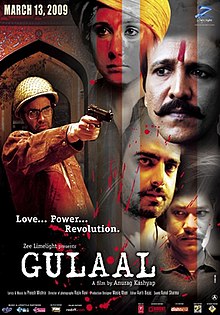(While the words ringing in my ear - )
ye duniya agar mil bhi jaye to kya hai ...
An impressive movie with a remarkable beginning and a little experiment with narrative. After a long gap, that of a week almost, suddenly
the images from the movie have began to flip in my mind.
ye duniya agar mil bhi jaye to kya hai ...
The whole mood of the movie is Disillusionment, and it is also one of its prominent themes. The Rajputanas of Rajasthan are disillusioned after Independence. They realize that their sacrifice, their blood, their treasure has all been wasted. They have not been given the Rights, the Reverence, the Privilege that they deserved. The Rajputs are only giving voice to the general disillusionment felt by everyone after Independence. Moreover, their agony has been highlighted by the fact that the Democracy or Government is doing the Same Thing that they have been accused of. And so, we all agree.
The political disillusionment is soon shifted to the disillusionment in all spheres of life : friendship, love, filial relations. Dilip Kumar is the one, trapped in all sorts of disillusionment. Beginning with his enrollment as a Law Student, paradoxically he ends up doing Unlawful actions. He is again disillusioned when he gets to know the Real Politics behind much simple looking college elections for college development. And at last, his disillusionment with Love.
One of the achievements of the movie is - it is symbolical - and the symbol is so well woven that only a critical and observant eye can catch it. Kay Kay Menon is outstanding while Ransa deserves much accolades. Piyush Mishra plays the Elizabethan Fool to the Court and King, here represented by Kay Kay Menon. The songs of the movie are Poetry in its best progressive movement tone (*).
There is a sort of Mass Mania in the movie. A mass mania, I would say, is, when common sense has been
given up for a foolish purpose by a certain group. The first thing that hit me was, a different side of Politics. Apart from all mania, stupidity, impossible and almost laughable purpose of Politics shown in Gulaal , the striking thing is , it is shown, grossly at the grass root level - College politics. Where the movies like Singham, Gangajal, Rajneeti, show you the Climax and End, from a very common perspective, of the Honest Policeman or Honest Game-playing Rajneta- Gulaal takes you back to the Beginning - the College Elections - the most hideous side of Politics.
Another fascinating thing about the movie is - its Title. Such a title invites number of interpretations, which is a pleasure to a searching mind like me. What Gulaal represents? Gulaal is the red color powder used in the Hindu festival - Holi. Thus it is symbolizes happiness, fraternity and love. But have you noticed Gulaal has been used since ages by Revolutionaries? Gulaal, in much Indian sense, also symbolizes Revolution. I have noticed one more thing these days, in all Hindu dharmik yatra or Julus , in which people dance in frenzy, Gulaal has been used, then, does it also symbolize Mania, Frenzy? Of course, the red color is a dynamic color - representing Contradictory emotions - On one hand, Anger, Hatred, Blood and one other hand, Love, passion, revolution. One color - many faces. That makes it just a perfect Title.
Well, look at the poster carefully.
(*) - Progressive Movement in Poetry of Hindi Literature was affected by Marxist Movement of Europe, Political turbulence at home and as a reaction of Chhayavaadi Kaavya. The most efficient representative of this Poetry is Ramdhari Singh Dinkar , and one of his most famous lines are - ' Sinhasan khali karo ki Janta aati hai...' , which was used by Jay narayan Prakash as a motto for his revolution.

No comments:
Post a Comment